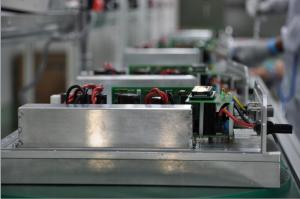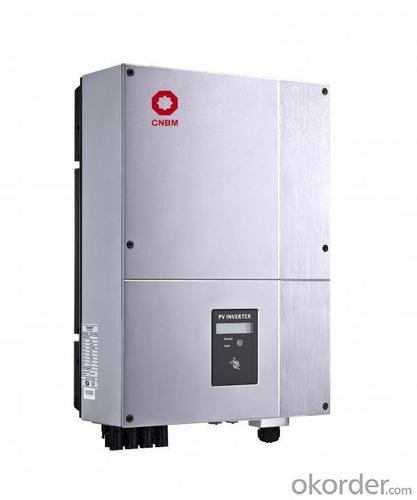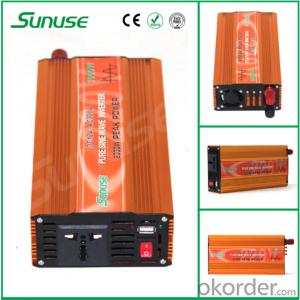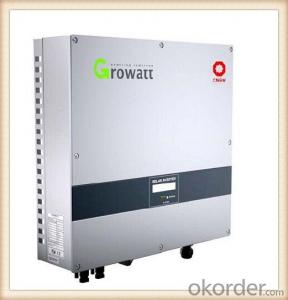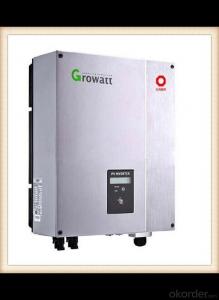Hyundai Solar Inverter CNBM-4200MTL Grid Tied Solar Inverter
- Loading Port:
- ShenZhen
- Payment Terms:
- TT
- Min Order Qty:
- 1 unit unit
- Supply Capability:
- 3000 per month unit/month
OKorder Service Pledge
OKorder Financial Service
You Might Also Like
Features of Grid Tied Solar Inverter CNBM-4200MTL
The full range of CNBM single phase inverters has received VDE, CE, G83/1, G59/2, ENEL2010, VDE4105, C10/C11, AS4777 etc.
With a R&D team more than 100 engineers,40% of the staff, who has been deeply engaged in the photovoltaic industry for 10 years, CNBM takes the mission to increase the inverter availability and efficiency, putting continuous innovation to make CNBM inverter easier for installation and operation, and more cost-effective for solar plant construction.Maximum efficiency of 97.8% and wide input voltage range, Internal DCswitch,MTL-String, Sound control,Bluetooth/RF technology /Wi-FiTransformerless,GT topology
Technical data of Grid Tied Solar Inverter CNBM-4200MTL
Model | CNBM-3600MTL | CNBM-4200MTL | |
Input data (DC) |
|
| |
Max. DC power | 3800W | 4200W | |
Max. DC voltage | 600V | 600V | |
Start voltage | 150V | 150V | |
PV voltage range | 100V-600V | 100V-600V | |
Max. input current | 10A | 15A | |
Number of MPP trackers /strings per MPP tracker | 2/2 | 2/2 | |
Output (AC) |
| ||
Rated AC output power | 3600W | 4200W | |
Max. AC power | 3600W | 4200W | |
Max. output current | 18A | 21A | |
Power factor | 1 | 1 | |
THDI | <3% | <3% | |
AC connection | Single phase | Single phase | |
Efficiency |
| ||
Max. efficiency | 97.6% | 97.9% | |
Euro weighted efficiency | 97% | 97.4% | |
MPPT efficiency | 99.5% | 99.5% | |
Protection devices |
| ||
Output over voltage protection-varistor | yes | yes | |
Ground fault monitoring | yes | yes | |
Grid monitoring | yes | yes | |
General Data |
| ||
Dimensions (W / H / D) in mm | 360/510/188 | 360/510/188 | |
Weight | 24KG | 24KG | |
Operating temperature range | –25°C ... +60°C | –25°C ... +60°C | |
Altitude | 2000m(6560ft) without derating | ||
Self-Consumption night | < 0.5 W | < 0.5 W | |
Topology | Transformerless | ||
Cooling concept | Natural | Natural | |
Environmental Protection Rating | IP65 | IP65 | |
Features |
| ||
DC connection | H4/MC4(opt) | H4/MC4(opt) | |
Display | LCD | LCD | |
Interfaces: RS485/RS232/Bluetooth / RF/Zigbee/Wifi | yes/yes/opt/opt/opt | ||
Warranty: 5 years / 10 years | yes /opt | ||
Certificates and approvals | CE、VDE 0126-1-1、DK5940、G83/1-1、G59/2、RD1663、EN50438、 VDE-AR-N4105、CEI-021、IEC-62109、ENEL-Guide | ||
CNBM-4200MTL is simple national setting of line supply monitoring, Easy country configuration, with Multi-language,display, currently available for most of the countries over the world.With technical creativity and scientific management, the factory established first class R&D and test centers, as well as management and R&D teams comprising of PhDs and masters with overseas qualification.
Figure 1 the application of Grid Tied Solar Inverter CNBM-4200MTL
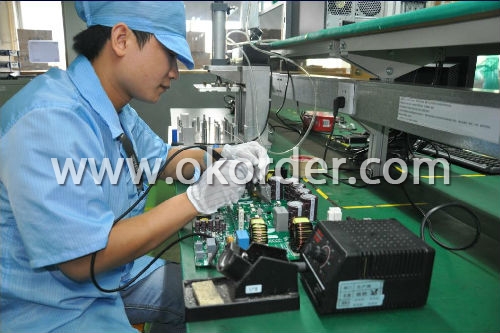
Figure 2 The Stock of Grid Tied Solar Inverter CNBM-4200MTL
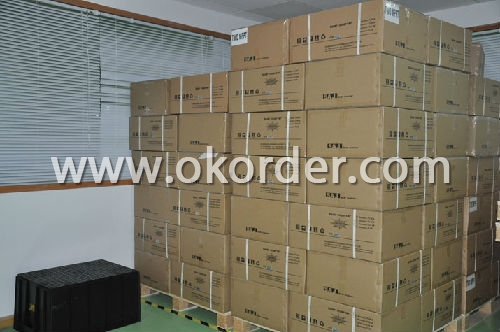
- Q: How does a solar inverter affect the overall system performance in different weather conditions?
- A solar inverter plays a crucial role in determining the overall system performance in different weather conditions. In situations with ample sunlight, a high-quality inverter optimizes the conversion of DC power generated by the solar panels into usable AC power. This ensures maximum energy output and efficient utilization of solar energy. However, in adverse weather conditions like cloudy or overcast skies, a good inverter can still extract a significant amount of power by employing advanced MPPT algorithms and voltage regulation techniques. It helps maintain system stability and mitigates power losses, thereby minimizing the impact of weather conditions on the overall system performance.
- Q: What is the role of a solar inverter in preventing electrical faults?
- The role of a solar inverter in preventing electrical faults is to convert the direct current (DC) generated by solar panels into alternating current (AC) that can be used by appliances and the electrical grid. By regulating and controlling the flow of electricity, a solar inverter ensures that the voltage and frequency levels are within acceptable limits, preventing overloading, overheating, and electrical faults that could potentially damage the system or cause safety hazards.
- Q: What are the potential risks of overloading a solar inverter?
- Overloading a solar inverter can lead to several potential risks. Firstly, it can cause the inverter to overheat, which can result in damage to the internal components and reduce its lifespan. Secondly, overloading can cause the inverter to shut down or trip, interrupting the solar power generation and potentially causing a power outage. Additionally, overloading the inverter may also compromise the safety of the electrical system, increasing the risk of electrical fires or other hazards. Therefore, it is important to ensure that the solar inverter is properly sized and not overloaded to avoid these potential risks.
- Q: Can a solar inverter be integrated with smart home systems?
- Yes, a solar inverter can be integrated with smart home systems. Smart home systems allow for the monitoring and control of various devices and appliances in a home, and a solar inverter can be integrated into this system to provide real-time data on solar energy production, as well as the ability to remotely control and optimize the solar power usage in the home.
- Q: How does a solar inverter handle voltage phase imbalance in the grid?
- A solar inverter handles voltage phase imbalance in the grid by monitoring the phase angles of the grid voltage and adjusting its output accordingly. It continuously measures the phase imbalance and corrects it by injecting reactive power into the grid. This helps to balance the voltage across the different phases and maintain stable grid conditions.
- Q: What is the difference between a PV grid-connected inverter and an off-grid inverter?
- Off-grid inverter is equivalent to their own to establish an independent small power grid, mainly to control their own voltage, is a voltage source.
- Q: What are the different power output modes of a solar inverter?
- The different power output modes of a solar inverter typically include grid-tie mode, off-grid mode, and hybrid mode. In grid-tie mode, the solar inverter synchronizes with the utility grid, allowing excess solar energy to be fed back into the grid. Off-grid mode, on the other hand, enables the solar inverter to operate independently, providing power to appliances and devices without the need for a utility grid connection. Hybrid mode combines the features of both grid-tie and off-grid modes, allowing the solar inverter to function with or without the grid, depending on the availability of solar energy and the user's preferences.
- Q: What is the efficiency rating of a solar inverter?
- The efficiency rating of a solar inverter refers to the percentage of solar energy converted into usable electricity. It measures how effectively the inverter converts the direct current (DC) power generated by solar panels into alternating current (AC) power for use in homes and businesses. Higher efficiency ratings indicate that the inverter can convert a greater amount of solar energy, resulting in increased electricity production and cost savings.
- Q: How does a solar inverter handle voltage and frequency variations caused by grid disturbances?
- A solar inverter is designed to handle voltage and frequency variations caused by grid disturbances by employing various control mechanisms and protection features. Firstly, the inverter continuously monitors the voltage and frequency levels of the grid, and it adjusts its output accordingly to match the grid's requirements. If there is a voltage or frequency fluctuation, the inverter will either increase or decrease the output power to maintain the desired voltage and frequency levels. To handle voltage variations, the solar inverter utilizes a voltage regulation mechanism. If the grid voltage increases or decreases beyond a certain threshold, the inverter adjusts its internal voltage regulation circuitry to ensure a stable and regulated output voltage. This helps protect the inverter and connected devices from potential damage due to overvoltage or undervoltage conditions. Similarly, to handle frequency variations, the solar inverter incorporates a frequency control mechanism. If the grid frequency deviates from the specified range, the inverter adjusts its internal frequency control circuitry to maintain a stable and accurate output frequency. This ensures that the power generated by the solar panels remains synchronized with the grid, allowing for efficient power transfer and preventing any damage to the inverter or connected devices. Furthermore, solar inverters often include advanced features such as anti-islanding protection. This feature detects any abnormal grid conditions, such as voltage or frequency fluctuations beyond a safe limit. If an islanding condition is detected, where the solar system continues to generate power even when the grid is down, the inverter will disconnect from the grid to prevent any potential safety hazards for utility workers. Overall, a solar inverter is designed to handle voltage and frequency variations caused by grid disturbances through continuous monitoring, voltage regulation, frequency control, and protective features. These capabilities ensure reliable and safe operation of the solar power system while maintaining a stable connection with the utility grid.
- Q: What is the maximum power output of a solar inverter?
- The maximum power output of a solar inverter depends on its capacity and specifications. It can range from a few hundred watts to several kilowatts for residential inverters, and even higher for commercial or utility-scale inverters.
Send your message to us
Hyundai Solar Inverter CNBM-4200MTL Grid Tied Solar Inverter
- Loading Port:
- ShenZhen
- Payment Terms:
- TT
- Min Order Qty:
- 1 unit unit
- Supply Capability:
- 3000 per month unit/month
OKorder Service Pledge
OKorder Financial Service
Similar products
Hot products
Hot Searches
Related keywords


